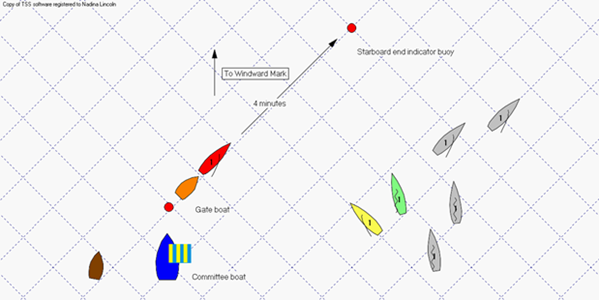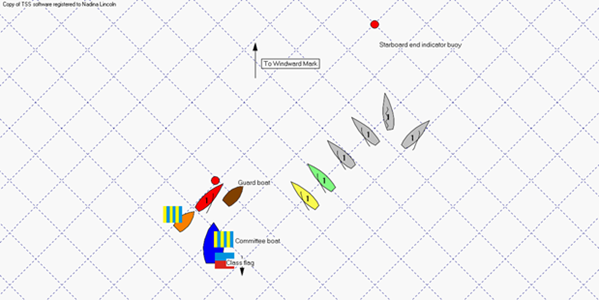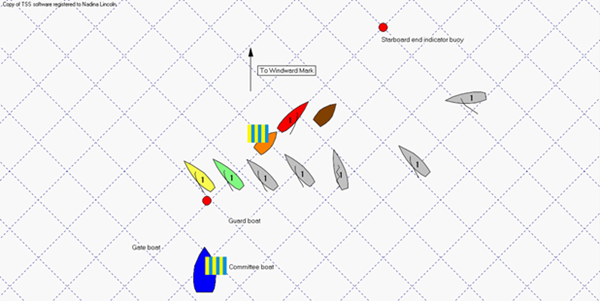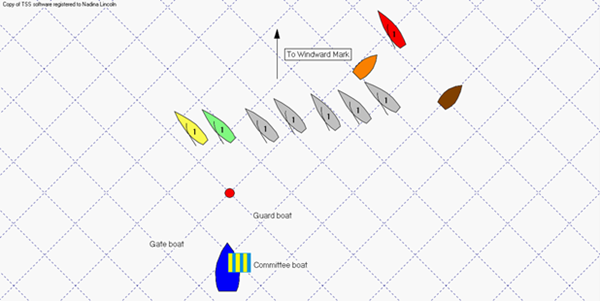Gate starts
The gate start was developed to improve race management for fleets of over 100 boats. It is now used by smaller fleets and can be a very fair way of starting races. The basic principle of a gate start is that a pathfinder starts at a fixed mark on port tack and all other boats cross behind her on starboard tack. The pathfinder is usually chosen from one of the leading boats in the fleet.
Conditions for a gate start
A fair gate start needs a wind which is steady in direction and strength. The sea conditions must be such that the pathfinder can sail a true course without having to play the waves for safety. Any tidal stream should be constant in rate and direction over the whole line.
Equipment
A manoeuvrable gate launch flying flag G
This acts as a moving starting mark at the starboard end of the line. It should be large enough for an Assistant RO, in addition to her normal crew. The gate launch should be;
- Capable of maintaining a true course astern of the pathfinder
- The boat should be capable of a speed of two knots more than the maximum speed of the pathfinder.
- The helm must be capable of maintaining a constant position astern of the pathfinder.
- The gate launch must be equipped with a tall signal mast, flags and an easily-visible compass.
A guard launch, flying flag U
The role of the guard boat is to protect the pathfinder as she sails along her port tack to open the start line. It should be comparable to the gate launch but only needs to be large enough for the normal crew. It should be a soft RIB in case of collisions.
Sailing Instructions
The Sailing Instructions should include the following:
- When flag G is displayed on the race committee boat a gate start will be used.
- The length of time the gate will be open.
- The number of minutes after the start that a boat may start.
- The system for determining the pathfinder.
- The gate launch, the guard launch and the pathfinder rank as starting marks.
- Any boat which is on the port side of the gate launch while the gate is opening has not crossed the starting line from the course side and needs to return to do so.
- After the preparatory signal a boat which interferes with or tries to pass between the pathfinder and the gate or guard launch, or that causes another boat to interfere in these ways, will be disqualified without a hearing. If the race is restarted, resailed or rescheduled she is not entitled to compete. This changes Rule 63.1.
- A boat that cannot avoid touching a starting mark may hail a right-of-way boat for room and shall retire
Further to the Sailing Instructions information, competitors new to Gate Starts appreciate a separate instruction possibly placed on the Official Notice Board going through the process.
Procedure for gate start
- Publicise the nominated pathfinder and reserve
The pathfinder for the first race will be nominated by the race committee. Subsequently, the pathfinder may be the tenth boat in the preceding race depending what is published in the SI’s. When she is unable to race, or has been the pathfinder previously in the event, the pathfinder will be the eleventh boat in the preceding race and so on. Her number will be posted on the official notice board or on the back of the committee boat.
- Station the committee boat in the vicinity of the leeward mark. The committee boat can remain mobile or can anchor, but it is usually preferable to anchor unless there is a clear reason not to do so. Display flag G on the committee boat to indicate it is on station and a gate start will be used.
- Lay a starting mark at the leeward end of the gate, about 50m to windward of the committee boat or lay a mark to indicate where the starting mark will A useful tip is to make the run into the pin a nice broad reach from mark 4P enabling accurate timings.

- Make all start signals from the committee
- Approx 5 minutes before the start meet the pathfinder at mark 4P and brief them what they are being asked to do. A simple laminated card is useful.
- At the prearranged meeting time meet at mark 4P and reach in a controlled manner towards the already laid pin mark arriving 15 seconds before the start.
- The pathfinder hardens up on Port tack and prepares to open the start line. The gate launch takes up position a few metres behind the pathfinder. The guard launch, takes up station 450 off the starboard bow of the pathfinder. She should be close enough to protect the pathfinder but not so close as to interfere with her ability to sail her port tack course.


- The starting line is between the starting mark and the stern of the gate launch.
- The pathfinder maintains her course until released by the race officer. This is usually a number of minutes after the start signal when the Gate Boat driver is happy they can maintain course and bearing. The path finder may then tack onto starboard tack.
- The guard launch then moves out of the way.
- The gate launch maintains her course and speed until a fixed time (defined in the sailing instructions) after the starting signal. When she stops she lowers flag G half way and makes a sound signal.
- Lower flag G on the committee boat at the same time. After this time a boat shall not start later than the number of minutes specified in the sailing instructions.

Gate start problems
A gate start should allow all competitors of all standards an equal start, but its smooth operation depends on the skills of the race committee, the pathfinder and the gate and guard launches.
A gate start may be subject to a general recall if the race officer considers the start is unfair, or when the pathfinder, gate or guard launch is interfered with by boats in such a way as to impede the operation of the gate.
The usual cause of a general recall is a bend in the wind or a substantial shift which favours one end of the line.
The pathfinder may cause problems with the start either by trying to start early or by bearing away into the waiting fleet to gain an unfair advantage. If the pathfinder is suspected of doing this, she should be warned and given one more chance and then if it happens again protested under Rule 2 or 69.
Guide to line length
The recommended time the start line is open is the number of boats x the time to travel one boat length. Time and Speed Charts in the Racing Rules of Sailing, provide the time it takes a boat to travel one length for different wind speeds. The average speed for most dinghies is 3-4 knots on the beat. For the faster dinghies their overall beam also needs to be considered, which includes the crew on a trapeze wire or outrigger. This is calculated using the Fiddle Factor. For most starts the fiddle factor is 1. However for catamarans or boats with wide beam this may be 1.25 or 1.5.
Example of start line time open calculation
|
Number of Boats |
Distance covered 1 length |
Fiddle factor |
Time in Seconds |
|
50 |
2.4 (Boat speed 4 knots) |
1 |
120 (2 Minutes) |
|
50 |
3.2 (Boat speed 3 knots) |
1 |
160 (2.5 Minutes) |
|
100 |
2.4 (Boat speed 4 knots) |
1 |
240 (4 Minutes) |
|
100 |
3.2 (Boat speed 3 knots) |
1 |
320 (5.3 Minutes) |
|
150 |
2.4 (Boat speed 4 knots) |
1 |
360 (6 Minutes) |
|
150 |
3.2 (Boat speed 3 knots) |
1 |
480 (8 Minutes) |
The line length for seventy RS 400 dinghies with 12 knots of wind would be: 70 x 2.4 x 1 = 168 seconds
This is then rounded up to nearest minute, i.e. 3 minutes.
Further information
This useful video made for the RS200 class, a frequent user of gate starts, will assist you.

